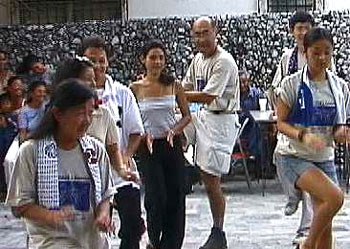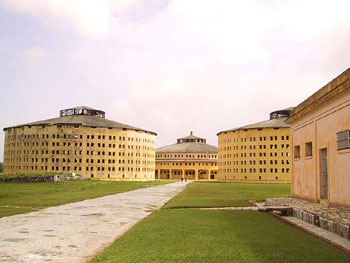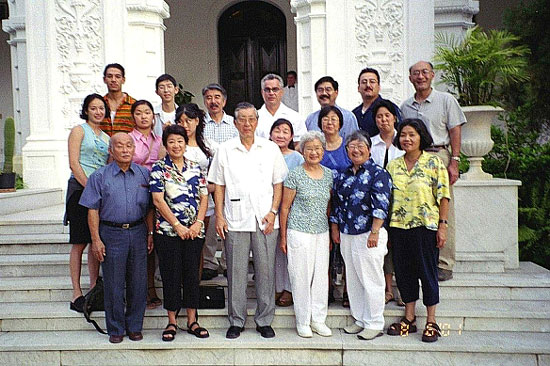Join us * for a Report from Cuban to the Community: Sunday, Sept. 30, 2001, 2 p.m., at JACCC

 |
| Obon dancing |
For 10 days this past August, 17 Asian Americans from Los Angeles went somewhere few Americans have seen first hand: Cuba. The recently returned delegation sponsored by Nikkei for Civil Rights and Redress (NCRR) will share their impressions of Cuba and details of exchanges with the Cuban Japanese community on Sunday, Sept. 30, 2001, 2 p.m., at the Japanese American Cultural and Community Center (JACCC) in Los Angeles' Little Tokyo. In addition to bringing needed medical supplies and Japanese foods, one of the goals of the delegation was to reintroduce Obon odori (obon dances).
The delegation, spanning in age from 18 to 75, will share stories, photos, slides and video from their visit. A short video edited down from over 16 hours shot by delegation member Janice Yen will give a glimpse into Cuba and the Cuban Japanese Obon festival held on the Isle of Youth. Some of the delegation's other visits included: an alternative medical clinic, a model organic farm run by a Cuban Japanese family, and grassroots community organizations--the backbone of the country.
In addition to participating in the Obon, delegation members also had the opportunity to visit Cuban Japanese families in their homes and share family histories. "I was really impressed by the Cubans and those that are hapa (half Cuban; half Japanese)," explained Nisei delegation member Haru Kuromiya. "They were really aware of their heritage."
Most Japanese immigrated to Cuba between 1910 and 1930 to find work, in much the same way Japanese American Issei did. Today, there are approximately 1,300 Cubans of Japanese ancestry out of a population of over 11 million in Cuba. Approximately 25 percent of Cuban Japanese live in and around Havana; 16 percent live on the Isle of Youth, where Issei men were imprisoned during World War II. The remainder are scattered throughout the other provinces of Cienfuegos, Camaguey, Pinar del Rio and Holguin.
 |
| Modelo prison: This is the prison where Cuban Japanese men were imprisoned during WWII. Fidel Castro was also held here before the Revolution. |
Two important highlights of the delegation's stay on the Isle of Youth included meeting the spry 95-year-old Mr. Miichiro Shimazu and 87-year-old Mrs. Kaoru Miyazawa, the two surviving Issei on the Isle; and touring the Presidio Modelo, a sprawling prison complex where over 300 Issei men from throughout Cuba were imprisoned during WWII.
Delegation members will also discuss their observations of Cuba's revolutionary society and its social and economic programs that include free health care and education (through college) to all Cubans. They will also share the effects of the last decade of economic downturn due to the pull out of aid from the former Soviet Union, and the difficulties resulting from ongoing U.S. Blockade against the tiny island nation.
The delegation resulted from the efforts of Judy Ota who had learned about the 100-year history of Japanese Cubans from Francisco Miyasaka, President of the Cuban Japanese Society, while she visited Cuba with her daughter a couple of years ago.
Upon her return to the US, Ota and her sister Kathy Masaoka organized a speaking tour for Miyasaka last summer to Southern and Northern California. The tour was sponsored by various local organizations, including NCRR, Cal State University Long Beach, Japanese American National Museum, Japanese American Historical Society of Southern California, Japanese American Citizens League Civil Rights Caucus and UCLA Asian American Studies Center.
Miyasaka spoke to capacity crowds at each event. At the culmination of the tour, he suggested that a Japanese American delegation visit the Isle of Youth for the annual Obon gathering held there. "Mr. Miyasaka saw his visit to California as the first official exchange between our communities and that the delegation to would be an important step in building an ongoing relationship between Japanese Americans and Cuban Japanese," explained Masaoka, who helped organize the group's trip to Cuba.
"I won't forget the experiences here," stated 21-year-old Khi-Min Jung. "It's not something you can learn in a classroom. One of my favorite parts was the CDR (Committee to Defend the Revolution) block party. The pride and the patriotism I saw there is what I'm envious of."
Join us * for a Report from Cuban to the Community:
Sunday, Sept. 30, 2001, 2 p.m., at JACCC
The Japanese American Cultural and Community Center (JACCC) is located at 244 San Pedro St., in downtown Los Angeles.
For more information, contact Tony Osumi at (310) 301-4915, Jenni Kuida at (213) 250-8800 or Sandy Maeshiro at (310) 837-7989.
*Delegation Members: Bruce Iwasaki, Naomi Iwasaki, Kenwood Jung, Khi-min Jung, Yuriko Jung, Suzy Katsuda, Jenni Kuida, Haru Kuramiya, Sandy Maeshiro, Dan Masaoka, Kathy Masaoka, Mark Masaoka, Mayumi Masaoka, Nobuko Miyamoto, Victor Shibata, Evelyn Yoshimura and Jan Yen).
 |
| Delegation at the Japanese Ambassador's residence |
|

